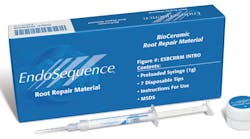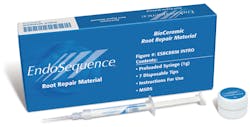Dr. Allen Ali Nasseh
March 25, 2013
As a practicing endodontist, I would like to share with you five tips for effective use of bioceramic technology in your general dental practice. These tips will allow you to not only perform better endodontics, but to accomplish it in a more expeditious manner. Additionally, for those dentists not yet using bioceramic sealers for their root canal therapy procedures, it is my hope this article will stimulate you to further investigate the use (and multiple applications) of this material.
Here are my five tips for using bioceramics in the general dental practice:
1. Do not store in a refrigerator. Store at room temperature.
EndoSequence BC Sealer (Brasseler USA, pictured above) comes premixed in a syringe which does not have to be stored in a refrigerator. In fact, since it is the moisture inherent in the dentinal tubules which initiates the setting reaction, it is strongly recommended not to keep it in a refrigerator. The introduction of an endodontic sealer that comes premixed in a syringe and can be stored at room temperature is a major upgrade from many of the previous sealers. The premixing not only insures a proper mix every time, but more importantly, it gives predictability to the clinician in terms of handling characteristics.
2. Use the bioceramic sealer as part of an advanced obturation technique.
In canals where the final prepared shape is round enough so that the master gutta-percha cone is in very close proximity to the prepared canal walls, simply inject a small amount of the bioceramic sealer into the canal and then take your EndoSequence Master Apical File (e.g. if size 40/.04 is the final instrumented size and a 40/.04 GP master cone has been verified to fit) and place it into the canal by hand (do not use a handpiece). While inserting the file into the canal, slightly turn it in a counterclockwise manner, so that the sealer is carried down with the file, as opposed to simply filling the flutes. Generally, one 360-degree rotation for the full length of the canal should be enough. Once the file reaches its apical termination, remove it from the canal with an additional counterclockwise motion. This action takes the sealer that was placed in the canal and simply spreads it against the walls. (Any excess sealer will fill in the flutes of the file.) Then you may simply coat the master cone with some sealer and gently insert it into the canal.
Particularly noteworthy with this technique is that this action of placing a file into the canal (prior to final obturation) helps to remove the excessive hydraulic force that may cause either sealer extrusion or trapping of the sealer under the cone (in the case of a closed apex) that may ultimately prevent the full seating of the master cone. It is also important to note that the reinsertion of the master apical file into a canal that has been previously disinfected (with our final disinfection protocol) is only made possible if this file has been wiped thoroughly with an alcohol gauze pad and properly disinfected (we recommend fitting your master cone, then placing both the master cone and the master file for each canal in full-strength bleach for one minute to disinfect it before placing inside the canal, during which time you can disinfect the canal more and proceed to dry it).
3. Do not use too much sealer. One option is to not place the syringe into the tooth.
Too often we see clinicians use too much sealer when performing obturation. This is true for any obturation technique. Also, for those doctors just beginning to use a bioceramic sealer, it may be wise to do a few cases where you simply syringe the material onto a glass slab (or pad). Then lightly coat the primary cone with sealer, and use this cone to deliver sealer into the canal (lightly coating the walls with BC Sealer). This particular method is similar to previous techniques, but the key is that this will allow you to get a feel for how the bioceramic material flows. This is very important. You will discover that the bioceramic sealer flows much better than conventional sealers. This is due to its small particle size (less than two microns).
4. Use a bioceramic root repair material for a single-visit direct pulp cap.
Bioceramic technology is available in the following forms: as a sealer in a premixed syringe, as a root repair material in a premixed syringe, and as a premixed putty in a glass jar. We favor the root repair material (particularly the putty) for direct pulp caps. The following technique can be used:After the placement of the bioceramic putty (over the exposure), we like to place a hard substance over the unset bioceramic material, because (in the past) a direct pulp capped tooth has usually been restored in two visits. Glass ionomer seems to be the best material for such a technique, prior to placing a permanent restoration, such as a bonded composite. It will be difficult to place a bonded restoration over the unset bioceramic material. Instead, place a thin layer of GIC over the pulp cap. The great news is that the ceramic particles in the GIC will bond to the ceramic particles in the bioceramic root repair material. Subsequently, the composite material can be bonded to the GIC, just like a conventional sandwich technique. This is a technique that works well and can be accomplished in an expeditious manner (single visit).
5. Using bioceramics as a perforation repair material.
Bioceramics are a great indication for perforation repairs. In particular, we like it for floor perforations. Historically, we have used amalgam, glass ionomer, super EBA, and MTA. All of these materials worked, but all had handling challenges. Now, when performing perforation repairs or apical surgery, we have the option of using either a bioceramic filling material that comes premixed in a syringe, or a premixed bioceramic putty that comes in a jar. Either way, this is so much easier than mixing MTA or super EBA. Furthermore, you are getting all the benefits associated with the physical properties of bioceramics. Once again, you can use the sandwich technique here and do your perforation repairs in a single visit using a combination of putty to repair the perforation and GIC to cover it and have a set surface to work with.
Summary
We have given you five tips for using bioceramic technology in your practice. Bioceramics and their use are not just limited to the specialist practice – they have great application of use for the general practitioner as well. If you have not yet experienced this material, we suggest that you make the effort to check it out. You will not be disappointed! For more information, please visit nasseh.net for videos that demonstrate the various applications of this technology.








